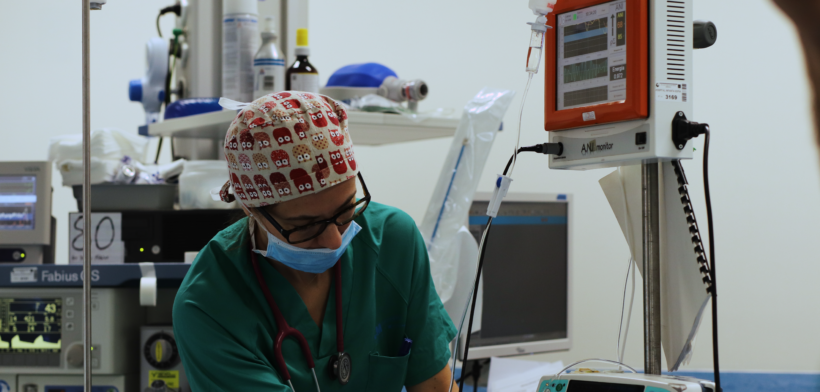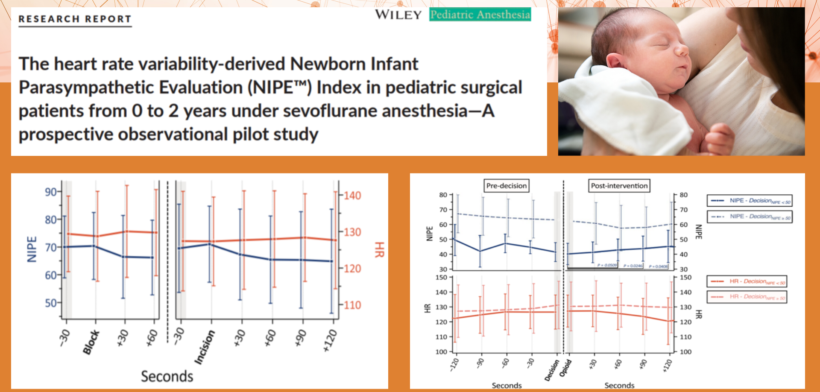If we think about the pain process (transduction, transmisión, modulation, and perception), as the last step is missing in unconsciousness, then we may realise that if a patient is unconscious, then, pain is not possible to occur. So analgesia is not needed. In another way, we could even say that classical hypnotic drugs like propofol are analgesics, as they produce unconsciousness and then perception cannot happen and analgesia appears.
In 1992 Anand et al (2) published in NEJM an interesting article about the administration of high doses of sulfentanyl to a group of neonates under cardiac surgery compared to a halothane morphine group, analyzing the outcomes of those young patients. The results about mortality were clear, 0 death among 30 in the sulfentanyl group and 4 deaths among 15 in the halothane group. What they were treating with the opioid was not pain but the response of the body to nociception as they were measuring catecolamines and they realize that the sulfentanyl group had a low surgical stress profile compared to the hallothane group.
Dr. Gray already had declared 30 years before this study, in his paper reassessment of the signs and level of anesthesia (3) that he was wrong when he defined the tríade of anesthesia and he changed the analgesia concept by réflex depression.
Pinscker et al in 1986 (4) in his publication in anesthesia analgesia:” Anesthesia: A pragmatic construct” says that any drug able to produce paralysis, unconsciousness, and attenuation of surgical stress can be used in anesthesia, opening the door to the now very famous concept of Opioid Free Anesthesia.
Later on, in 1997 Dr. Eger(5) already went further and defined anesthesia as amnesia and areflexia.
And finally, in 1999, an editorial in anesthesiology by Ebert called “Is gaining control of the autonomic nervous system important to our specialty?”(6), concludes that the main task of the anesthesiologist is to control the response of the autonomic nervous system and not the pain as this does not exist, indicating, in addition, that Heart Rate Variability is the best way to assess this system and that it might be an indicator of mortality and frailty in noncardiac surgeries.
Therefore, it is clear, that the problem is to control the autonomic nervous system, and in order to measure its activity, Heart Rate Variability has been pointed out as the best way to do it. (7)
The ANI monitor provides the value of the high-frequency band normalized of the Heart Rate Variability in real-time, and the energy value ( the total variability in the ECG signal, SDNN). These two metrics will help clinicians to know where the autonomic nervous system of their patient is to provide the best care.
There is growing evidence that guiding your drugs with ANI will reduce the post-operative pain of your patients(8), but very recently a new study has been published in COVID19 patients, Aragon et at (9)were using these metrics to assess the status of the autonomic nervous system of these covid19 patients finding out that those with a weak autonomic response were more likely to die than those with a strong one. This paper opens the possibility of using this metric in other areas like septic patients (10) or in detecting frailty (11) for including those patients in rehabilitation programs before surgery.
What is sure is that we have to measure the autonomic nervous system in order to provide our patients with the best care.
(1) Methyl-n-propyl ether G J REES, T C GRAY. Br J Anaesth 1950 Apr;22(2):83-91. DOI: 1093/bja/22.2.83 PMID: 15411475
(2) Halothane-morphine compared with high-dose sufentanil for anesthesia and postoperative analgesia in neonatal cardiac surgery.Anand KJ, Hickey PR.N Engl J Med. 1992 Jan 2;326(1):1-9. doi: 10.1056/NEJM199201023260101
(3) A reassessment of the signs and levels of anaesthesia.GRAY C. Ir J Med Sci. 1960. PMID: 13708030
(4) Anesthesia: a pragmaticconstruct.Pinsker MC.Anesth Analg. 1986 Jul;65(7):819-20.PMID: 3717622
(5) Hypothesis: inhaled anesthetics produce immobility and amnesia by different mechanisms at different sites E I Eger d et al Anesth Analg . 1997 Apr;84(4):915-8. doi: 10.1097/00000539-199704000-00039.PMID: 9085981
(6) Is gaining control of the autonomic nervous system important to our specialty? Ebert TJ.Anesthesiology. 1999 Mar;90(3):651-3. doi: 10.1097/00000542-199903000-00004.PMID: 10078663
(7) Heart rate variability: standards of measurement, physiological interpretation and clinical use. Task Force of the European Society of Cardiology and the North American Society of Pacing and Electrophysiology Circulation. 1996 Mar 1;93(5):1043-65.
( 8)Intraoperative “Analgesia Nociception Index”-Guided Fentanyl Administration During Sevoflurane Anesthesia in Lumbar Discectomy and Laminectomy: A Randomized Clinical Trial Henry D Upton et al Anesth Analg. 2017 Jul;125(1):81-90.doi: 10.1213/ANE.0000000000001984.
(9)Correction: Is the heart rate variability monitoring using the analgesia nociception index a predictor of illness severity and mortality in critically ill patients with COVID-19? A pilot study.Aragón-Benedí C, Oliver-Forniés P, Galluccio F, Altinpulluk EY, Ergonenc T, El Sayed Allam A, Salazar C, Fajardo-Pérez M.PLoS One. 2021 May 20;16(5):e0252259. doi: 10.1371/journal.pone.0252259. eCollection 2021.PMID: 34015062
(10) Heart rate variability measures as predictors of in-hospital mortality in ED patients with sepsis Wei-Lung Chen et al Am J Emerg Med. 2008 May;26(4):395-401.doi: 10.1016/j.ajem.2007.06.016.
(11) Role of heart-rate variability in preoperative assessment of physiological reserves in patients undergoing major abdominal surgery.Reimer P et al, Clin Risk Manag. 2017 Sep 19;13:1223-1231. doi: 10.2147/TCRM.S143809. eCollection 2017.PMID: 29033572


